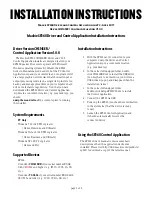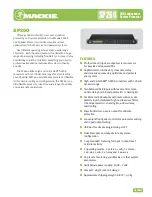
Glossary
GL-2
7986-A2-GB20-00
September 1998
Data Terminal Loopback. LoopBack mode that loops the data for a particular synchronous
data port back to the port just before it is combined with the rest of the T1 data stream.
Data Terminal Ready. A signal from the DTE to the modem, sent via Pin 20 of the
EIA-232 interface (V.24 circuit 108/1, /2), that indicates the DTE is turned ON and
connected to the modem.
A wideband digital interface operating at 2.048 Mbps, defined by ITU recommendations
G.703 and G.704. It is used primarily outside North America.
Excessive Error Rate. An error rate that is greater than the threshold that has been
configured in the device.
Embedded Operations Channel. An in-band channel between DSL devices, used for
4 kbps management data.
Errored Seconds. A second with one or more ESF error events (one or more CRC6 error
events or OOFs).
Extended SuperFrame. The T1 transmission standard that specifies 24 frames as an
extended superframe to be used for frame synchronization and to locate signaling bits.
A type of network that supports high-speed communication among systems. It is a widely
implemented standard for LANs. All hosts are connected to a coaxial cable where they
contend for network access using a Carrier Sense, Multiple Access with Collision
Detection (CSMA/CD) paradigm.
European Telecommunications Standardization Institute. An organization that produces
technical standards in the area of telecommunications.
A predetermined set of configuration options containing the optimum settings for operation
on asynchronous dial networks.
Frame Alignment Signal. A loss of signal (LOS) error detection.
Frame Alignment Word. A loss of synchronization error detection.
Federal Communications Commission. The Board of Commissioners that regulates all
electrical communications that originate in the United States.
Far-End Block Error. Block errors reported by remote equipment.
A high-speed connection-oriented packet switching WAN protocol using variable-length
frames.
File Transfer Protocol. A TCP/IP standard protocol that allows a user on one host to
access and transfer files to and from another host over a network, provided that the client
supplies a login identifier and password to the server.
An ITU recommendation for the physical and logical characteristics of hierarchical digital
devices.
An ITU recommendation for synchronous frame structures.
High Density Bipolar Three Zeros Substitution. A line coding technique used to
accommodate the ones density requirements of E1 lines.
High-bit-rate Digital Subscriber Line. A technique for high bandwidth, bidirectional
transmission over copper wire for T1 and E1 services.
Internet Protocol. An open networking protocol used for internet packet delivery.
Internet Protocol address. The address assigned to an internet host.
Local Area Network. A privately owned and administered data communications network
limited to a small geographic area.
DTLB
DTR
E1
EER
EOC
ES
ESF
Ethernet
ETSI
factory defaults
FAS
FAW
FCC
FEBE
frame relay
FTP
G.703
G.704
HDB3
HDSL
IP
IP address
LAN
Summary of Contents for Hotwire 7986 M/HDSL
Page 68: ...Testing 5 10 7986 A2 GB20 00 September 1998 This page intentionally left blank...
Page 80: ...Security 7 6 7986 A2 GB20 00 September 1998 This page intentionally left blank...
Page 106: ...Standards Compliance for SNMP Traps B 6 7986 A2 GB20 00 September 1998...
Page 114: ...Technical Specifications D 2 7986 A2 GB20 00 September 1998 This page intentionally left blank...







































